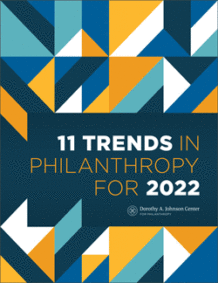Innovations in Talent Investment for Individuals, Organizations, and Communities


 This article was first published in our 11 Trends in Philanthropy for 2022 report. Explore all 11 trends in the full report.
This article was first published in our 11 Trends in Philanthropy for 2022 report. Explore all 11 trends in the full report.The nonprofit sector employs 12.5 million people in the United States (Salamon & Newhouse, 2020) and its people power is its most finite and important resource.
Since its founding in 2014, Fund the People has made the argument that “nonprofit people are nonprofit programs,” and that support for the nonprofit workforce is an “effective strategy for increasing performance, impact, and sustainability” (2017, para. 1).
Yet, the social sector has traditionally underinvested in that talent. Though direct figures for how much each nonprofit spends on professional development are not readily available, foundations invest approximately $29 per person via grants for leadership development compared to their for-profit counterparts’ rate of $120 per person (Callanan, 2014).
“[F]oundations invest approximately $29 per person via grants for leadership development compared to their for-profit counterparts’ rate of $120 per person.”
However, change appears to be on the horizon. Due to the combined pressures of several internal and external drivers, and accelerated by the pandemic, the sector is reflecting on its current models of talent management and deepening its focus on talent support. New efforts to experiment with and invest in talent are cropping up nationwide. While they remain generally small in scale, these efforts are gaining attention and proponents.
In their 2020 report, Awake to Woke to Work, Equity in the Center found that while just 10% of nonprofit CEOs/executive directors are from the Black, Indigenous, and people of color community, there is more diversity at the beginning of the talent pipeline.
ProFellow’s 2020 Fellowship Industry Report found both that 1) more fellowship programs are focusing on early- and mid-career professionals, and 2) that the growth of professionally-focused fellowship programs in the last 20 years is rooted in the sector’s efforts to support a more inclusive workforce (Yadav & Johnson, 2020). Ninety-three percent of their survey respondents noted actively working toward recruiting diverse fellows as a key priority.
While the impact of these programs remains challenging to quantify, the report shares many case studies from fellowship programs that are already changing the game.
With new, more sophisticated tools available for collaboration, and remote work a fact of daily life, employees are demanding more flexibility and organizations are providing it. Millions of American workers have pulled up stakes and moved wholesale to new cities and states (Molinski, 2021).
“[M]any foundations with place-based interests have begun offering incentives for workers from any sector to move to town — either to take new jobs or to continue in their existing positions from a new part of the country.”
Interestingly, philanthropy was playing an innovative role in facilitating both remote work and this internal migration even before the pandemic. In the last several years, many foundations with place-based interests have begun offering incentives for workers from any sector to move to town — either to take new jobs or to continue in their existing positions from a new part of the country.
Remote work is making this migration possible; philanthropy’s incentives are making it attractive. Examples include:
According to an article in the Chronicle of Philanthropy, “The effort in Northwest Arkansas is part of an increasing number of philanthropy-financed projects trying to spark economic development, promote civic and cultural life, attract skilled workers, and offset declining or sparse populations” (Perkins, 2021, para. 5).
While these programs are not aimed at supporting individual development, or even talent for the philanthropic sector alone, they are investments in the overall talent ecosystem and communities’ abilities to provide vibrant environments.
Under the burdens of overwork and isolation, and often as a response to calls in the sector for more leadership opportunities for women and people of color, many nonprofits and foundations are now adopting co-leadership or distributed leadership models. These organizations are embracing a reorganization of decision-making stresses and a redistribution of work. And they’re embedding talent development strategies within their new models:
Jenny Lee, the executive director of AMP, led the organization’s transition to a co-leadership model. Lee stated: “My desire for a Co-Executive Director is in part about adding capacity. Directing AMP is a huge role that could easily amount to two full time jobs. But it is also about alleviating the loneliness of being an ED” (2020, para. 5).
In our conversations with various organizations on this subject, the reasons for adopting co-leadership models were near-universal: supporting more diverse talent and making leadership roles more sustainable.
As Inside Philanthropy’s Dawn Wolfe (2021b) reports, there are still very few foundations offering paid sabbaticals for nonprofit leaders. The Durfee Foundation, Barr Foundation, Colorado Health Foundation, and a scant few others are the only ones on the list.
However, also in large part driven by pandemic-related burnout, many of the funders on this short list are adding sabbatical spots to their programs in the coming year and beyond. The Durfee Foundation and Virginia G. Piper Charitable Trust also reported a slight uptick in interest in their sabbatical programs from foundation peers (Wolfe, 2021a).
It appears that more organizations are beginning to heed the call (Durfee Foundation, 2017; Center for Nonprofit Excellence, 2018) for restorative and strategic breaks for leaders in high-stress roles. Coverage from journalists and bloggers like Dawn Wolfe, NPQ’s Steve Dubb (2018), and Vu Le (2020) will help drive this trend.
Research suggests that investments in workplace culture that create a supportive learning environment and positive employee experience are key to attracting and retaining talent. As the competition for employees increases, top-notch salaries, flexible work environments, and restorative leadership programs centered on equity are critically needed to ensure the health of nonprofit organizations.



Callanan, L. (2014, February 11). Under-investing in social sector leadership. Foundation Center. https://pndblog.typepad.com/pndblog/2014/02/underinvesting-in-social-sector-leadership.html
Dimovska, D., Sommer, S., & Segura, F. (2021, June 14). Can co-leadership be the future of philanthropy? Alliance Magazine. https://www.alliancemagazine.org/analysis/can-co-leadership-be-the-future-of-philanthropy/
Dorsey, C., Bradach, J., & Kim, P. (2020, May 4). Racial equity and philanthropy: Disparities in funding for leaders of color leave impact on the table. The Bridgespan Group and Echoing Green. https://www.bridgespan.org/insights/library/philanthropy/disparities-nonprofit-funding-for-leaders-of-color
Equity in the Sector. (2020). Awake to woke to work: Building a race equity culture. https://equityinthecenter.org/aww/
Fund the People. (2017, September 19). Intro to Fund the People Toolkit. http://fundthepeople.org/toolkit/about/
The Journal Record. (2021, September 24). Tulsa Remote initiative spreading to other cities, regions. https://journalrecord.com/2021/09/24/tulsa-remote-initiative-spreading-to-other-cities-regions/
Lee, J. (2020, January 28). The Chrysalis Continues. In Allied Media Projects. Retrieved from https://alliedmedia.org/news/chrysalis-continues
Linnell, D. S., & Wolfred, T. (2009). Creative disruption. Third Sector New England and CompassPoint Nonprofit Services. https://www.tsne.org/sites/default/files/Creative-Disruption_0.pdf
Molinski, M. (2021, July 30). Summer of move: More Americans now migrating than any time in years. Investor’s Business Daily. https://www.investors.com/news/moving-during-covid-turns-into-great-migration-americans/
National Council of Nonprofits. (2021, November 15). The scope and impact of nonprofit job vacancies. https://www.councilofnonprofits.org/sites/default/files/documents/nonprofit-job-vacancies-report-preliminary-results.pdf
Perkins, O. (2021, September 21). Foundations offer incentives to help cities attract workers willing to relocate. Chronicle of Philanthropy. https://www.philanthropy.com/article/foundations-offer-incentives-to-help-cities-attract-workers-willing-to-relocate
Reynolds, B. W. (2021, April 12). The environmental impacts of remote work: Stats and benefits. Flexjobs. https://www.flexjobs.com/blog/post/telecommuting-sustainability-how-telecommuting-is-a-green-job
Salamon, L. M., & Newhouse, C. L. (2020, June). 2020 nonprofit employment report. Johns Hopkins Center for Civil Society Studies. http://ccss.jhu.edu/wp-content/uploads/downloads/2020/06/2020-Nonprofit-Employment-Report_FINAL_6.2020.pdf
Thomas-Breitfeld, S., & Kunreuther, F. (2020, June 18). The race gap: Opportunities to lead nonprofits are still unequal. Chronicle of Philanthropy. https://www.philanthropy.com/article/The-Race-Gap-Opportunities-to/249011
Thomas-Breitfeld, S., & Kunreuther, F. (2020). Race to lead revisited: Obstacles and opportunities in addressing the nonprofit racial leadership gap. Building Movement Project. https://buildingmovement.org/wp-content/uploads/2020/07/RTL_Revisited_National-Report_Final.pdf
Thomas-Breitfeld. S. (n.d.). About. LinkedIn. Retrieved January 7, 2022, from https://www.linkedin.com/in/seandtb?trk=author_mini-profile_title
TSNE. (n.d.) Report: Creative disruptions. TSNE MissionWorks. https://www.tsne.org/creative-disruption
Tulsa Remote. (n.d.). Benefits. https://tulsaremote.com/
Wolfe, D. (2021a, July. 29). Nonprofit leaders need a break. Will more funders start backing sabbaticals? Inside Philanthropy. https://www.insidephilanthropy.com/home/2021/7/29/nonprofit-leaders-need-a-break-will-more-funders-start-backing-sabbaticals
Wolfe, D. (2021b, August 3). Funders who back sabbaticals for nonprofit leaders. Inside Philanthropy. https://www.insidephilanthropy.com/home/2021/8/3/need-a-break-heres-the-short-list-of-funders-who-back-sabbaticals-for-nonprofit-leaders
Yadav, N. & Johnson, V.A. (Eds.). (2020). Fellowship industry report: Industry trends and promising approaches to impact evaluation and diversity, equity and inclusion. ProFellow, LLC. https://www.profellow.com/2020-fellowship-industry-report